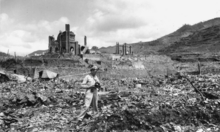Daniel A. McGovern | |
|---|---|
 Lt.Col Dan A. McGovern at Nagasaki ground zero on September 9, 1945 | |
| Born | December 6, 1909 Monaghan, Ireland |
| Died | December 14, 2005 (aged 96) Laguna Woods, California |
| Buried | Ascension Cemetery, Lake Forest, California |
| Service/ | Air Force |
| Rank | Lieutenant colonel |
| Known for | Filming aftermath of Hiroshima and Nagasaki bombings |
| Spouse(s) | Virginia Scott |
| Children | 4 |
Lieutenant colonel Daniel A. McGovern was the first American to film the aftermath of the atomic bombings of Hiroshima and Nagasaki.[1] The United States Army Air Forces officer, who was both a combat cameraman and a specialist in assessing the effective of bomb damage, made the films in September 1945. The evidence that McGovern collected from Japan was shown to J. Robert Oppenheimer and the team which created the weapons. Concerned that the US government might censor the images, McGovern kept secret original prints. He made these prints available to US congress in 1967.[1]
McGovern was personal photographer to US president Franklin D. Roosevelt. [2]
Early life[edit]
Daniel A. McGovern was born in Monaghan, Ireland on December 6, 1909. His father was a sergeant of the Royal Irish Constabulary.[3] He grew up in Carrickmacross, where he saw the Irish War of Independence.[3] McGovern would later recall "As the son of an RIC man, it was difficult for me to get along with the other young fellows. They would often abuse me, kick me and gang up on me. I had to defend myself".[4] After the signing of the Anglo-Irish Treaty in 1921 and the Partition of Ireland, Monaghan (along with the Ulster counties of Cavan and Donegal) opted to join the Republic of Ireland. In 1922, 12-year-old McGovern left Ireland emigrated with his family to the United States.[3]
Military career[edit]
In 1934, McGovern enlisted in the US Army.[5] Shortly after the United States entered World War Two, McGovern became cameraman-photographer for President Franklin Roosevelt.[3] He organized the Army Air Forces combat camera training school in Hollywood, California.[3] He flew as a photographer on B-17 bombing missions over Europe; his footage was incorporated into the 1944 hit documentary Memphis Belle: A Story of a Flying Fortress.[3] He survived two plane crashes.[2]
After the war, McGovern was assigned to Lookout Mountain Air Force Station, a secret underground photo lab and studio in Hollywood hills.[2] He filmed atomic tests in Nevada and the Pacific.[6] He became chief of the technical photographic facility at Holloman Air Force Base. He retired in 1961 with the rank of Lt. Colonel.[3][5]
Atomic bombings[edit]
In September 1945 Lt. Col McGovern became the first American to start documenting the destruction caused by the atomic bombings of Hiroshima and Nagasaki. His classified work was shown to Oppenheimer and the Manhattan Project. Due to his concern that his films would be censored by the US government, McGovern made secret copies of his original films. These were presented to a US Congressional committee in 1967 when the original films could not be found. Joseph McCabe, McGovern's biographer, said "McGovern's story is better, in my opinion, than Oppenheimer's."[1]
Later life[edit]
McGovern founded the International Combat Cameramen Association to "give credit to those who put their life on the line to capture combat footage".[7][2] In December 1996, he appeared on television episode dedicated to exposing the Alien Autopsy footage as a fake.[8]
Personal life[edit]
During World War Two, McGovern married Virginia Scott; the pair had four children and were married until her death in March 2005.[2] McGovern died on December 14, 2005.[2]
Legacy[edit]
In 2021, McGovern's life was the subject of a book titled "Rebels to Reels: A Biography of Combat Cameraman Daniel A. McGovern USAF".[9][6][3]
References[edit]
- ^ a b c "Oppenheimer: Monaghan man who captured nuclear devastation". BBC News. 31 March 2024.
- ^ a b c d e f "Daniel McGovern, WWII Photographer, Dies at 96". Washington Post. December 20, 2005.
- ^ a b c d e f g h "Life of famous US military photographer Daniel A McGovern recalled in new book by Joe McCabe". Independent.ie. July 21, 2022.
- ^ "The Monaghan man who filmed the devastation of Nagasaki and Hiroshima". IrishCentral.com. July 21, 2023.
- ^ a b "Daniel A. McGovern Collection". Library of Congress, Washington, D.C. 20540 USA.
- ^ a b Carroll, Rory (July 31, 2022). "US airman who rescued film of A-bomb horrors is honoured at last" – via The Guardian.
- ^ "Daniel A McGovern | American Air Museum".
- ^ Rebels to Reels
- ^ "The Irishman who filmed Hiroshima and Nagasaki". The Irish Times.